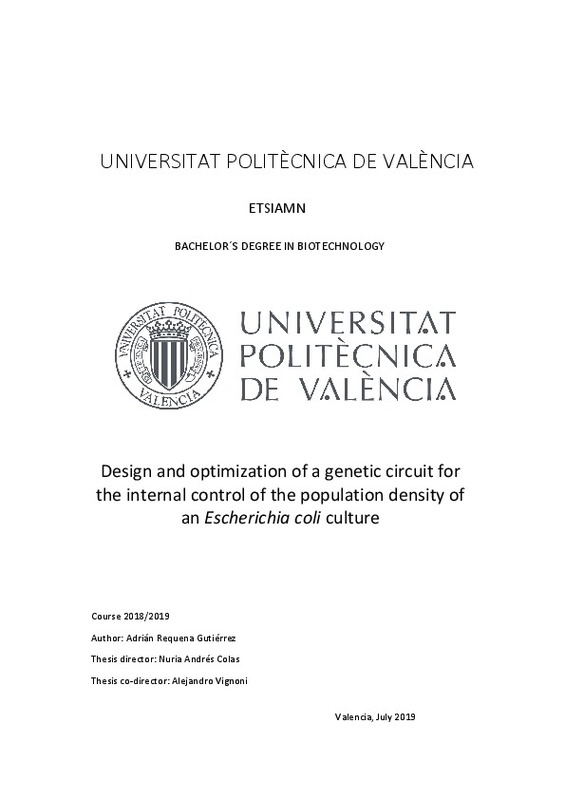|
Resumen:
|
[ES] La biología sintética permite la construcción de circuitos genéticos con un comportamiento deseado, tomando como ejemplo, modificando y combinando diferentes elementos genéticos y mecanismos moleculares concretos que ...[+]
[ES] La biología sintética permite la construcción de circuitos genéticos con un comportamiento deseado, tomando como ejemplo, modificando y combinando diferentes elementos genéticos y mecanismos moleculares concretos que existen en la naturaleza. Esta capacidad le ha dado a la biología sintética un gran potencial en el aprovechamiento de todas las herramientas que ofrece la biología. Como parte de la biología sintética, la modelación matemática permite hacer predicciones del comportamiento de un circuito genético, a partir de los datos conocidos de las diferentes reacciones bioquímicas que ocurren en el organismo y de sus parámetros cinéticos. Además, permite conocer qué parámetros de estas reacciones deben ser modificados para obtener el comportamiento deseado y, con ello, realizar un diseño racional de las construcciones genéticas.
En este trabajo se han utilizado métodos de biología sintética para el diseño de un circuito genético para limitar la densidad poblacional de un cultivo de Escherichia coli dentro de un rango. Para ello, el circuito genético se ha basado en el uso del quorum sensing, descubierto en la bacteria Vibrio fischeri, y consiste en un gen letal cuya expresión es dependiente de la densidad poblacional. De esta manera, cuando la densidad poblacional alcanza un determinado valor se activa la expresión del gen letal y produce la muerte de gran parte de la población celular. Aquellos individuos que sobreviven continuarán multiplicándose hasta alcanzar nuevamente la densidad poblacional suficiente para la activación del gen letal. De esta forma se consigue un comportamiento oscilante entre dos puntos de densidad poblacional. Además, se ha incorporado a la construcción una unidad transcripcional de la proteína fluorescente verde (GFP) regulada de la misma manera que el gen letal, de modo que sirva de marcador para poder realizar un seguimiento del comportamiento del circuito. Este tipo de circuitos genéticos puede tener aplicación en el diseño de organismos sintéticos para la liberación periódica de fármacos in situ.
En particular, para el diseño racional de este circuito genético se ha desarrollado un modelo matemático que permite representar el comportamiento dinámico deseado. Para obtener predicciones de dicho comportamiento, se han caracterizado las diferentes partes que componen al circuito genético y estos resultados se han combinado con el modelo desarrollado. El circuito se ha construido utilizando métodos de ensamblaje de alta eficiencia propios de la biología sintética, que permiten construir el circuito a partir de sus diferentes partes básicas de DNA. El comportamiento de las bacterias con el circuito genético incorporado se ha seguido mediante la medición de la densidad óptica del cultivo y la fluorescencia emitida por la GFP. Dichas medidas han sido utilizadas para comparar y ajustar el modelo al comportamiento real. Por último, este proceso también ha permitido determinar qué parámetros biológicos deben ajustarse para alcanzar el comportamiento deseado.
[-]
[EN] Synthetic biology allows the construction of genetic circuits with a desired behavior taking as an example, modifying and combining different genetic elements and specific molecular mechanisms that exist in nature. ...[+]
[EN] Synthetic biology allows the construction of genetic circuits with a desired behavior taking as an example, modifying and combining different genetic elements and specific molecular mechanisms that exist in nature. This capability gives synthetic biology a great potential in the use of all the tools that biology offers. As part of synthetic biology, mathematical modeling allows to make predictions of the behavior of a genetic circuit, from known data of the different biochemical reactions that occur in the organism and its kinetic parameters. In addition, it allows to know which parameters of these reactions must be modified to obtain the desired behavior and, with it, to make a rational design of the genetic constructs.
In this work, synthetic biology methods have been used to design a genetic circuit that limits the population density of an Escherichia coli culture within a range. For this, the genetic circuit has been based on the use of quorum sensing, discovered in the bacterium Vibrio fischeri, and consists of a lethal gene whose expression is dependent on population density. In this way, when the population density reaches a certain value, the expression of the lethal gene is activated and produces the death of a large part of the cell population. Those individuals that survive will continue multiplying until reaching again the sufficient population density for the activation of the lethal gene. Thus, an oscillating behaviour is achieved between two points of population density. In addition, a transcriptional unit of green fluorescent protein (GFP) regulated in the same way as the lethal gene has been incorporated into the construct, so that it can serve as a marker to monitor the behaviour of the circuit. This type of genetic circuits can be applied in the design of synthetic organisms for periodic drug delivery in situ.
In particular, for the rational design of this genetic circuit, a mathematical model that can represent the desired dynamic behavior has been developed . In order to obtain predictions of this behavior, the different parts that compose the genetic circuit have been characterized and these results have been combined with the developed model. The circuit has been constructed using high-efficiency assembly methods characteristic of synthetic biology, which allow to construct the circuit from its different basic parts of DNA. The behavior of the bacteria with the incorporated genetic circuit has been followed by measuring the optical density of the culture and the fluorescence emitted by the GFP. These measurements have been used to compare and adjust the model to the actual behavior. Finally, this process has also made it possible to determine which biological parameters must be adjusted to achieve the desired behavior.
[-]
|





![PDF file [Pdf]](/themes/UPV/images/pdf.png)


